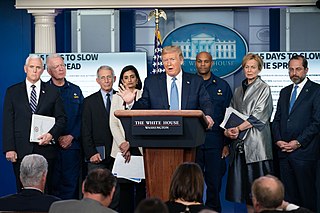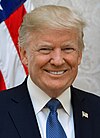Related Research Articles

The COVID-19 pandemic has had far-reaching consequences beyond the spread of the disease itself and efforts to quarantine it, including political, cultural, and social implications.

The COVID-19 pandemic in the United States is part of the worldwide pandemic of coronavirus disease 2019. More than 31.7 million confirmed cases have been reported since January 2020, resulting in more than 568,000 deaths, the most of any country, and the sixteenth-highest per capita worldwide. The U.S. has about one fifth of the world's cases and deaths. More Americans have died from COVID-19 than died during both World Wars and the Vietnam War combined. COVID-19 became the third-leading cause of death in the U.S. in 2020, behind heart disease and cancer. U.S. life expectancy dropped from 78.8 years in 2019 to 77.8 years in the first half of 2020.

As of 13 March 2020, when the number of new cases became greater than those in China, the World Health Organization (WHO) began to consider Europe the active centre of the COVID-19 pandemic. Cases by country across Europe had doubled over periods of typically 3 to 4 days, with some countries showing doubling every 2 days.

The first cases of the COVID-19 pandemic of coronavirus disease 2019 in North America were reported in the United States in January 2020. Cases were reported in all North American countries after Saint Kitts and Nevis confirmed a case on 25 March, and in all North American territories after Bonaire confirmed a case on 16 April.
The COVID-19 pandemic was confirmed to have reached Cyprus in March 2020. The released data from the Cyprus government includes cases in the British Overseas Territory of Akrotiri and Dhekelia but, due to the long-running Cyprus dispute, does not include cases in Northern Cyprus.

On March 11, 2020, the National Basketball Association (NBA) announced the suspension of the 2019–20 season following Utah Jazz center Rudy Gobert testing positive for coronavirus disease 2019 (COVID-19).

The COVID-19 pandemic in Washington, D.C., is part of the ongoing COVID-19 pandemic in the United States. The first cases relating to the pandemic in Washington, D.C. were reported on March 7, 2020. The city has enacted a variety of public health measures in an attempt to curb the spread of the virus.

The COVID-19 pandemic was confirmed to have reached the U.S. state of North Carolina on March 3, 2020.

The COVID-19 pandemic in Minnesota is part of an ongoing pandemic of coronavirus disease 2019 (COVID-19) in the state of Minnesota. The first confirmed case was reported on March 1, 2020.
The following is a timeline of the COVID-19 pandemic in the United States during 2020.

This article documents the chronology of the response to the COVID-19 pandemic in March 2020, which originated in Wuhan, China in December 2019. Some developments may become known or fully understood only in retrospect. Reporting on this outbreak began in December 2019.

This article documents the chronology of the response to the COVID-19 pandemic in April 2020, which originated in Wuhan, China in December 2019. Some developments may become known or fully understood only in retrospect. Reporting on this pandemic began in December 2019.

The World Health Organization is a leading organization involved in the global coordination for mitigating the COVID-19 pandemic, within the broader United Nations response to the pandemic caused by the emergence of severe acute respiratory syndrome coronavirus 2 in late 2019.

The COVID-19 pandemic has had a significant impact on the military. Many military training and exercises have been postponed or cancelled.

The Donald Trump administration communicated in various ways during the COVID-19 pandemic in the United States, including via social media, interviews, and press conferences with the White House Coronavirus Task Force. Opinion polling conducted in mid-April 2020 indicated that less than half of Americans trusted health information provided by Trump and that they were more inclined to trust local government officials, state government officials, the Centers for Disease Control and Prevention (CDC), and National Institute of Allergy and Infectious Diseases director Dr. Anthony Fauci.

This article documents the chronology of the response to the COVID-19 pandemic in May 2020, which originated in Wuhan, China in December 2019. Some developments may become known or fully understood only in retrospect. Reporting on this pandemic began in December 2019.

This article documents the chronology of the response to the COVID-19 pandemic in June 2020, which originated in Wuhan, China in December 2019. Some developments may become known or fully understood only in retrospect. Reporting on this pandemic began in December 2019.

The federal government of the United States initially responded to the COVID-19 pandemic in the country with various declarations of emergency, some of which led to travel and entry restrictions, and the formation of the White House Coronavirus Task Force. As the pandemic progressed in the U.S. and throughout the rest of the world, the U.S. government began issuing recommendations regarding the response by state and local governments, as well as social distancing measures and workplace hazard controls. Following the closure of most businesses throughout a number of U.S. states, President Donald Trump announced the mobilization of the National Guard in the most affected areas.

The first responses of the government of India to the COVID-19 pandemic in the country involved thermal screenings of passengers arriving from China, the country from which the coronavirus disease 2019 originated, as well as of passengers arriving from other countries. As the pandemic spread worldwide, the Indian government recommended social distancing measures and also initiated travel and entry restrictions. Throughout March 2020, several shutdowns and business closures were initiated, and by the end of the month, the Indian government ordered a widespread lockdown. An economic package was announced in May 2020.
The following is a timeline of major events leading up and during the 2020 United States presidential election, the 59th quadrennial United States presidential election, from January to October 2020. For previous events, see Timeline of the 2020 United States presidential election (2017–2019). For subsequent events, see Timeline of the 2020 United States presidential election
References
- ↑ Orr, Gabby. "Trump ratchets up coronavirus battle with European travel ban". Politico .
- ↑ https://www.cnbc.com/2020/03/11/top-federal-health-official-says-coronavirus-outbreak-is-going-to-get-worse-in-the-us.html
- ↑ https://www.espn.com/espn/story/_/id/30546338/visual-line-day-changed-everything-march-11
- ↑ https://www.foxbusiness.com/markets/us-markets-march-9-2020
- ↑ https://www.yahoo.com/lifestyle/stock-market-news-live-updates-march-11-2020-115430808.html
- ↑ . https://www.espn.com/espn/story/_/id/30546338/visual-line-day-changed-everything-march-11
- ↑ https://www.espn.com/espn/story/_/id/30546338/visual-line-day-changed-everything-march-11
- ↑ Karni, Annie; Haberman, Maggie (March 12, 2020). "In Rare Oval Office Speech, Trump Voices New Concerns and Old Themes". The New York Times .
- ↑ https://www.nytimes.com/2020/03/12/us/politics/trump-coronavirus-address.html
- ↑ https://www.nytimes.com/2020/03/11/us/politics/trump-coronavirus-speech.html
- ↑ https://www.nytimes.com/2020/03/11/us/politics/trump-coronavirus-speech.html
- ↑ https://www.factcheck.org/2020/03/factchecking-trumps-coronavirus-address/
- ↑ https://amp.abc.net.au/article/12051232
- ↑ https://www.factcheck.org/2020/03/factchecking-trumps-coronavirus-address/
- ↑ https://vtdigger.org/2020/03/12/fact-checking-donald-trumps-mistakes-about-european-travel-due-to-coronavirus/
- ↑ https://www.politifact.com/article/2020/mar/12/fact-checking-donald-trumps-mistakes-about-europea/
- ↑ https://khn.org/news/trump-wrongly-said-health-insurers-will-pay-for-all-coronavirus-treatment/
- 1 2 3 Larison, Daniel (March 12, 2020). "Trump's Botched Coronavirus Speech". The American Conservative . Retrieved March 19, 2020.
- ↑ Lipson, David (March 12, 2020). "Donald Trump's address was meant to lay out US plans to tackle coronavirus. Instead it sparked confusion". ABC News (Australia) . Retrieved March 19, 2020.
- ↑ Mackey, Robert (March 12, 2020). "Trump Mistakenly Announces Ban on All Travel and Imports From Europe, Then Backtracks". The Intercept. Retrieved March 21, 2020.
- ↑ Sandler, Rachel (March 11, 2020). "Trump Announces Broad Travel Ban On Europe—But Restrictions Target 'Foreign Nationals'". Forbes. Retrieved March 21, 2020.
- ↑ Chappell, Bill (March 12, 2020). "Coronavirus: Chaos Follows Trump's European Travel Ban; EU Says It Wasn't Warned". National Public Radio. Retrieved March 21, 2020.
- ↑ Wilkie, Christina (March 11, 2020). "Trump suspends travel from Europe for 30 days as part of response to 'foreign' coronavirus". NBC News. Retrieved March 21, 2020.
- ↑ LeBlanc, Paul (March 12, 2020). "Trump calls coronavirus a 'foreign virus' in Oval Office address". CNN. Retrieved March 21, 2020.
- ↑ Lowry, Rich (March 11, 2020). "Trump Strikes the Right Tone". National Review. Retrieved March 19, 2020.
- ↑ Goodwin, Michael (March 12, 2020). "Trump passes coronavirus test with flying colors: Goodwin". New York Post. Retrieved March 19, 2020.

